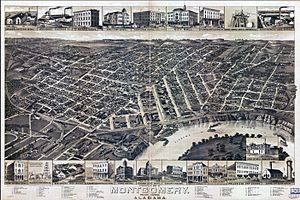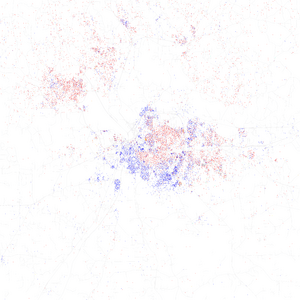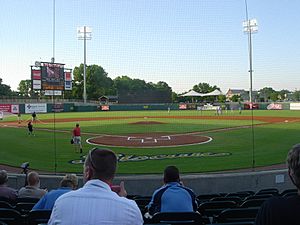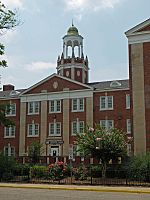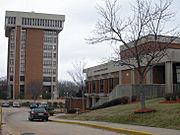Montgomery, Alabama facts for kids
Quick facts for kids
Montgomery
|
|||||
|---|---|---|---|---|---|
|
Montgomery along the Alabama River
Commerce Street, downtown
|
|||||
|
|||||
| Nickname(s):
"The Gump", "Birthplace of the Civil Rights Movement", "Cradle of the Confederacy"
|
|||||
| Motto(s):
"Capital of Dreams"
|
|||||
| Country | United States | ||||
| State | Alabama | ||||
| County | Montgomery | ||||
| Incorporated | December 3, 1819 | ||||
| Named for | Richard Montgomery | ||||
| Government | |||||
| • Type | Mayor–Council | ||||
| Area | |||||
| • Capital City | 162.27 sq mi (420.28 km2) | ||||
| • Land | 159.86 sq mi (414.03 km2) | ||||
| • Water | 2.41 sq mi (6.25 km2) | ||||
| Elevation | 240 ft (73 m) | ||||
| Population
(2020)
|
|||||
| • Capital City | 200,603 | ||||
| • Estimate
(2022)
|
196,986 | ||||
| • Rank | US: 133rd AL: 3rd |
||||
| • Density | 1,232/sq mi (475.8/km2) | ||||
| • Urban | 254,348 (US: 159th) | ||||
| • Urban density | 1,752.9/sq mi (676.8/km2) | ||||
| • Metro | 385,460 (US: 142nd) | ||||
| • Metro density | 142.0/sq mi (54.83/km2) | ||||
| Time zone | UTC−6 (Central (CST)) | ||||
| • Summer (DST) | UTC−5 (CDT) | ||||
| ZIP Codes |
ZIP Codes
|
||||
| Area code(s) | 334 | ||||
| FIPS code | 01-51000 | ||||
| GNIS feature ID | 0165344 | ||||
Montgomery is the capital city of Alabama, a state in the United States. It is also the main city of Montgomery County. The city is named after Richard Montgomery, a general from the American Revolutionary War. It sits next to the Alabama River on the coastal plain near the Gulf of Mexico. In 2020, about 200,603 people lived there. This makes it the third largest city in Alabama.
Montgomery was formed in 1819 when two towns along the Alabama River joined together. It became the state capital in 1846. In 1861, Montgomery was chosen as the first capital of the Confederate States of America. However, the capital later moved to Richmond, Virginia. In the mid-1900s, Montgomery became a very important place for the Civil Rights Movement. Big events like the Montgomery bus boycott and the Selma to Montgomery marches happened here.
Today, Montgomery is home to many Alabama government offices. It also has a large military base, Maxwell Air Force Base. The city has several universities, high-tech factories, and fun cultural spots. These include the Alabama Shakespeare Festival and the Montgomery Museum of Fine Arts. Montgomery is also known for making its downtown area look new and exciting.
Contents
History
Early Days and Native Americans
Before Europeans arrived, the Alabama River area was home to the Alibamu tribe of Native Americans. They were part of the Mississippian culture, which built large mounds across the Midwest and South. The first Europeans to visit were Hernando de Soto and his team in 1540. They passed through two Alibamu towns: Ikanatchati and Towassa.
Later, in 1716, James McQueen, a Scottish trader, became the first European to settle here. He married a Native American woman. In 1785, Abraham Mordecai set up a trading post. He brought the first machine for cleaning cotton, called a cotton gin, to Alabama.
Becoming a City and Capital
After the Creek War ended in 1814, Native American tribes had to give up a lot of their land to the United States. In 1816, Montgomery County was created. The first white settlers, led by General John Scott, founded Alabama Town. Soon after, Andrew Dexter Jr. started another town nearby called New Philadelphia. He even set aside a hill, "Goat Hill," for a future state capitol building.
These two towns, Alabama Town and New Philadelphia, joined together on December 3, 1819. They became the town of Montgomery. The city grew quickly because of the cotton trade. In 1846, Montgomery became the capital of Alabama, moving the capital from Tuscaloosa.
Civil War and Beyond
In February 1861, representatives from several Southern states met in Montgomery. They formed the Confederate States of America. Montgomery was chosen as its first capital, and Jefferson Davis became its president on the steps of the State Capitol. The capital later moved to Richmond, Virginia. In April 1865, Union soldiers captured Montgomery during the Civil War.
In 1886, Montgomery was the first city in the U.S. to have electric streetcars all over the city. This system was called the Lightning Route. It helped people move to new "suburban" areas.
Civil Rights Movement
In the mid-1900s, Montgomery became a key place for the Civil Rights Movement. This movement worked to gain equal rights for African Americans. On December 1, 1955, Rosa Parks was arrested in Montgomery for refusing to give up her bus seat to a white man. This event started the Montgomery Bus Boycott. Martin Luther King Jr., who was a pastor at Dexter Avenue Baptist Church in Montgomery, helped lead this boycott. After a court ruling, the city ended bus segregation.
In 1961, groups called Freedom Riders rode buses into Montgomery to protest segregation on interstate travel. They faced violence, but their actions helped lead to laws against segregation in public transportation.
Martin Luther King Jr. returned to Montgomery in 1965 for the Selma to Montgomery marches. These marches helped push for the Voting Rights Act of 1965. This law made sure all citizens could vote.
Modern Montgomery
In recent years, Montgomery has worked to make its downtown area better. The city has a plan to improve the riverfront and historic areas. Many old buildings are being turned into new apartments, restaurants, and shops. A new white water park also opened in 2023.
Geography
Montgomery is located at 32°21′42″N 86°16′45″W. The city covers about 162.27 square miles (420.28 km2). Most of this is land, with a small amount of water. The city has rolling hills and is about 220 feet (73 meters) above sea level.
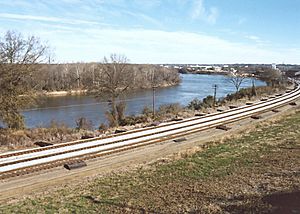
Cityscape and Landmarks
Downtown Montgomery is on the south bank of the Alabama River. The tallest building in the city is the RSA Tower, which is 375 feet (114 meters) tall. Many government buildings are downtown, including the Alabama State Capitol. The Capitol sits on a hill at one end of Dexter Avenue. The Dexter Avenue Baptist Church, where Martin Luther King Jr. was a pastor, is also on this street. Both are important National Historic Landmarks.
Near the Capitol is the First White House of the Confederacy. This was the home of President Jefferson Davis during the Civil War. Union Station is another historic landmark. It used to be a train station but is now part of the Riverfront Park. This park has an amphitheater, a riverboat dock, and Riverwalk Stadium.
The city has also worked to improve downtown with new shops and restaurants. Old Alabama Town shows off more than 50 old buildings from the 1800s. The National Memorial for Peace and Justice opened in 2018. It helps people remember the history of racial injustice in America.
South of downtown is Alabama State University, a historically black university. The Garden District and Cloverdale Historic District are nearby. These areas have many old homes from the late 1800s and early 1900s.
The east side of Montgomery is growing fast. It has the city's largest shopping malls and many new homes. This area is also home to the Wynton M. Blount Cultural Park. Here you can find the Alabama Shakespeare Festival and the Montgomery Museum of Fine Arts.
Climate
Montgomery has a warm, humid subtropical climate. Winters are short and mild, while summers are long, hot, and humid. The average temperature in January is about 46.6°F (8.1°C). In July, the average is 81.8°F (27.7°C). It often gets above 90°F (32°C) in summer. Rain falls throughout the year, with more rain in February, March, and July. Snow is rare and usually light.
| Climate data for Montgomery, Alabama (1991–2020 normals, extremes 1872–present) | |||||||||||||
|---|---|---|---|---|---|---|---|---|---|---|---|---|---|
| Month | Jan | Feb | Mar | Apr | May | Jun | Jul | Aug | Sep | Oct | Nov | Dec | Year |
| Record high °F (°C) | 83 (28) |
86 (30) |
90 (32) |
94 (34) |
99 (37) |
106 (41) |
107 (42) |
106 (41) |
106 (41) |
102 (39) |
91 (33) |
85 (29) |
107 (42) |
| Mean maximum °F (°C) | 75.6 (24.2) |
78.8 (26.0) |
84.7 (29.3) |
87.4 (30.8) |
93.1 (33.9) |
96.9 (36.1) |
98.3 (36.8) |
98.9 (37.2) |
95.7 (35.4) |
90.1 (32.3) |
82.7 (28.2) |
77.6 (25.3) |
99.6 (37.6) |
| Mean daily maximum °F (°C) | 59.8 (15.4) |
64.7 (18.2) |
71.9 (22.2) |
78.8 (26.0) |
86.0 (30.0) |
91.5 (33.1) |
93.7 (34.3) |
93.6 (34.2) |
89.3 (31.8) |
80.2 (26.8) |
69.8 (21.0) |
61.9 (16.6) |
78.4 (25.8) |
| Daily mean °F (°C) | 48.1 (8.9) |
52.6 (11.4) |
59.2 (15.1) |
65.7 (18.7) |
73.6 (23.1) |
80.2 (26.8) |
82.9 (28.3) |
82.5 (28.1) |
77.8 (25.4) |
67.4 (19.7) |
56.6 (13.7) |
50.2 (10.1) |
66.4 (19.1) |
| Mean daily minimum °F (°C) | 36.5 (2.5) |
40.4 (4.7) |
46.5 (8.1) |
52.6 (11.4) |
61.3 (16.3) |
69.0 (20.6) |
72.1 (22.3) |
71.4 (21.9) |
66.3 (19.1) |
54.5 (12.5) |
43.3 (6.3) |
38.6 (3.7) |
54.4 (12.4) |
| Mean minimum °F (°C) | 19.1 (−7.2) |
23.6 (−4.7) |
28.8 (−1.8) |
37.3 (2.9) |
47.3 (8.5) |
60.1 (15.6) |
66.7 (19.3) |
64.2 (17.9) |
53.0 (11.7) |
37.3 (2.9) |
26.7 (−2.9) |
23.2 (−4.9) |
17.1 (−8.3) |
| Record low °F (°C) | 0 (−18) |
−5 (−21) |
17 (−8) |
28 (−2) |
40 (4) |
48 (9) |
59 (15) |
56 (13) |
39 (4) |
26 (−3) |
13 (−11) |
5 (−15) |
−5 (−21) |
| Average precipitation inches (mm) | 4.64 (118) |
4.88 (124) |
5.21 (132) |
3.99 (101) |
3.88 (99) |
4.08 (104) |
5.06 (129) |
4.02 (102) |
3.69 (94) |
2.87 (73) |
3.85 (98) |
4.99 (127) |
51.16 (1,299) |
| Average snowfall inches (cm) | 0.0 (0.0) |
0.0 (0.0) |
0.3 (0.76) |
0.0 (0.0) |
0.0 (0.0) |
0.0 (0.0) |
0.0 (0.0) |
0.0 (0.0) |
0.0 (0.0) |
0.0 (0.0) |
0.0 (0.0) |
0.1 (0.25) |
0.4 (1.0) |
| Average precipitation days (≥ 0.01 in) | 10.4 | 9.5 | 9.1 | 7.7 | 8.1 | 10.3 | 11.7 | 9.7 | 6.5 | 6.4 | 7.0 | 10.2 | 106.6 |
| Average snowy days (≥ 0.1 in) | 0.1 | 0.0 | 0.1 | 0.1 | 0.0 | 0.0 | 0.0 | 0.0 | 0.0 | 0.0 | 0.0 | 0.1 | 0.4 |
| Average relative humidity (%) | 69.8 | 66.5 | 66.0 | 66.8 | 70.6 | 71.7 | 75.7 | 76.0 | 73.9 | 71.1 | 71.7 | 70.9 | 70.9 |
| Average dew point °F (°C) | 34.9 (1.6) |
36.9 (2.7) |
44.2 (6.8) |
52.0 (11.1) |
60.4 (15.8) |
66.9 (19.4) |
70.7 (21.5) |
70.3 (21.3) |
65.1 (18.4) |
53.4 (11.9) |
45.5 (7.5) |
38.5 (3.6) |
53.2 (11.8) |
| Mean monthly sunshine hours | 153.1 | 166.0 | 219.4 | 250.8 | 267.4 | 261.8 | 262.1 | 251.9 | 226.4 | 228.3 | 171.4 | 153.1 | 2,611.7 |
| Percent possible sunshine | 48 | 54 | 59 | 64 | 62 | 61 | 60 | 61 | 61 | 65 | 54 | 49 | 59 |
| Source: NOAA (snow 1981–2010, relative humidity and sun 1961−1990) | |||||||||||||
People and Population
| Historical population | |||
|---|---|---|---|
| Census | Pop. | %± | |
| 1830 | 695 | — | |
| 1840 | 2,179 | 213.5% | |
| 1850 | 4,728 | 117.0% | |
| 1860 | 8,843 | 87.0% | |
| 1870 | 10,588 | 19.7% | |
| 1880 | 16,713 | 57.8% | |
| 1890 | 21,883 | 30.9% | |
| 1900 | 30,346 | 38.7% | |
| 1910 | 38,136 | 25.7% | |
| 1920 | 43,464 | 14.0% | |
| 1930 | 66,079 | 52.0% | |
| 1940 | 78,084 | 18.2% | |
| 1950 | 106,525 | 36.4% | |
| 1960 | 134,393 | 26.2% | |
| 1970 | 133,386 | −0.7% | |
| 1980 | 177,857 | 33.3% | |
| 1990 | 187,106 | 5.2% | |
| 2000 | 201,568 | 7.7% | |
| 2010 | 205,764 | 2.1% | |
| 2020 | 200,603 | −2.5% | |
| 2022 (est.) | 196,986 | −4.3% | |
| U.S. Decennial Census 2020 Census |
|||
In 2020, Montgomery had 200,603 people living in the city. There were 82,835 households. About 24.9% of the people were under 18 years old. The median age was 34 years. This means half the people were younger than 34 and half were older.
Economy
Montgomery has always been a center for processing crops like cotton and peanuts. It is also a major shipping hub because of its location on the Alabama River and its train connections. In recent years, Montgomery has added more jobs in healthcare, business, government, and manufacturing.
Major Employers
Many different organizations provide jobs in Montgomery. Here are some of the biggest employers:
- Maxwell Air Force Base: A large military base.
- State of Alabama: State government jobs.
- Montgomery Public Schools: Jobs in public education.
- Baptist Health and Jackson Hospital & Clinic, Inc.: Hospitals and clinics.
- Hyundai Motor Manufacturing Alabama: Makes cars.
- ALFA Companies: Insurance.
- City of Montgomery: Local government jobs.
- Koch Foods: Processes poultry.
- Rheem Water Heaters: Makes water heaters.
- UPS and Glovis Alabama, LLC: Shipping and logistics.
Fun and Culture
Montgomery has a lively arts scene. The Winton M. Blount Cultural Park is home to the Montgomery Museum of Fine Arts. This museum has collections of American art and works from European artists.
The Montgomery Zoo has over 500 animals from five different continents. If you like music, the Hank Williams Museum has a huge collection of items from the famous country singer. The Museum of Alabama is the official state history museum. It was updated in 2013 with new exhibits. The W. A. Gayle Planetarium offers tours of the night sky and shows about space.
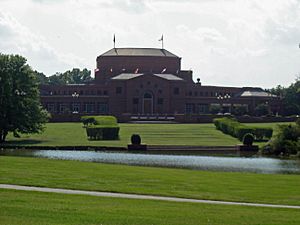
The Alabama Shakespeare Festival performs plays all year, including works by William Shakespeare. The Davis Theatre for the Performing Arts hosts the Montgomery Symphony Orchestra and dance groups. The Capri Theatre shows independent films. The Montgomery Performing Arts Center hosts many different shows, from Broadway plays to concerts.
Many famous musicians are from Montgomery, including jazz singer Nat King Cole and country star Hank Williams. Author and artist Zelda Sayre was also born here. Her house is now the F. Scott and Zelda Fitzgerald Museum.
Sports
Montgomery is home to the Montgomery Biscuits baseball team. They are part of the Class AA Southern League and are connected to the Tampa Bay Rays. They play at Montgomery Riverwalk Stadium.
The city also hosts college sports events. The Alabama State University Hornets play in NCAA Division I. Auburn University at Montgomery (AUM) and Huntingdon College also have sports teams. The Blue–Gray Football Classic was a famous college football game held here for many years.
Education
Most schools in Montgomery are part of the Montgomery Public Schools system. In 2022, there were over 26,000 students. The system has elementary, middle, and high schools. Montgomery is one of the few cities in Alabama with three public schools that offer International Baccalaureate programs. LAMP High School was named one of the top public high schools in the U.S. in 2022.
Montgomery has several universities. Alabama State University is a historically black university that moved to Montgomery in 1887. Troy University has a campus downtown, which includes the Rosa Parks Library and Museum. Auburn University at Montgomery is in the eastern part of the city. Private colleges like Faulkner University and Huntingdon College are also in Montgomery.
Maxwell Air Force Base is home to Air University, which is where the United States Air Force trains its officers.
Transportation
Two major highways run through Montgomery: Interstate 65 (north-south) and Interstate 85 (east-west). The city also has a public bus system called the Montgomery Area Transit System (The M). The Montgomery Regional Airport handles commercial flights and is an Air National Guard base.
Images for kids
-
Union Station Montgomery, around 1900
See also
 In Spanish: Montgomery (Alabama) para niños
In Spanish: Montgomery (Alabama) para niños














